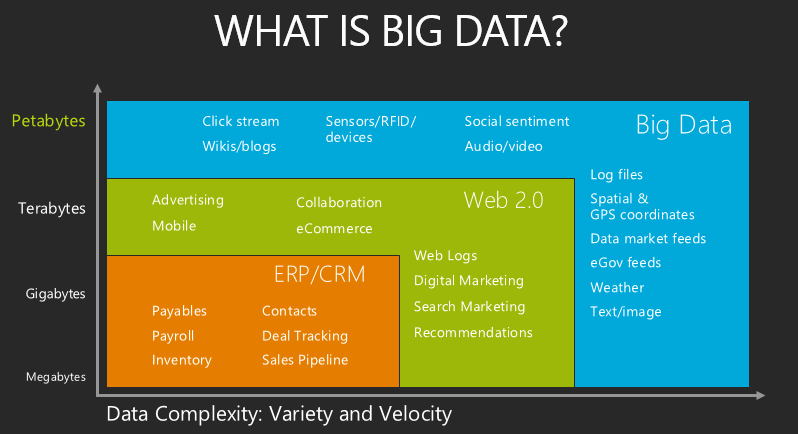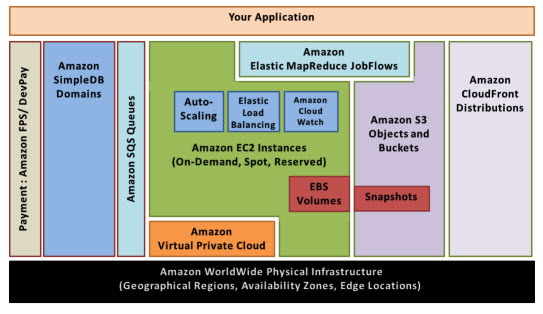Evolution
of Big data
Let’s dive today
about the real time examples. The enormous data growth now presented a big
challenge for the organizations who wanted to build intelligent systems based
on the data and provide near real time superior user experience to their
customers. Data was received from the transaction system and overnight was
processed to build intelligent reports from it. This kind of approach is a data warehouse
concept where it had its own share of challenges whenever unstructured data is
stored. Now the traditional database has limits to store large volumes
of data that comes in variety. Hence to cover this gap, big data science
evolved with the idea of capturing the data and present to the customers in an
innovative approach.
What is the role of Cloud computing in Big Data?
Cloud computing- It’s one of the hottest buzzword in IT world. It refers to
use of scalable public computer network for data storage and to perform
computing tasks. One of the easiest example to explain cloud computing is
Dropbox. It allows us to store and access your documents via internet
connection.
In the cloud
architecture there are 3 models developed over time;
Private cloud – As the word suggests, its intended for one
organization and do not share physical resources. Data center is managed
internally.
Public cloud – This one is developed by commercial providers
like Amazon, that hides the complex infrastructure and provides various
resource services.
Hybrid cloud – It is mix of both Private and Public cloud
that helps in achieving security, elasticity and cheaper load capabilities. It
can have huge impact to organizations if they are serviced poorly.
Cloud and Big Data – characteristics
Below is the list
of characteristics of cloud computing
·
Sc ability
·
Elasticity
·
Low cost
Things
to watch out in future:
IT companies rely
heavily on cloud computing integrated solutions to deliver quality projects
that delivers business needs. There are few things to consider when deploying
big data on cloud solutions.
·
Check on Data Integrity issues
·
Initial cost
·
Performance issues
·
Data Access security requirements
Use case Example for Big-Data
Let’s consider a
Retail Industry and how big data rules Retail sector
In the past we
know that stores that reacted to the demand where growing vastly. But today due
to rapid growth of technologies top retailers rely on Big data to gain a
competitive advantage.
Big data helps to
focus on:
Ø Predicting trends in the market and preparing for future
demand
Ø
Real time analytics helps the company to synchronize prices
hourly with demand.
Ø
Performs deeper analytics on all data to find hidden
insights.
Big Data analytics is now being
applied at every stage of the retail process – working out what the popular
products will be by predicting trends, forecasting where the demand will be for
those products, optimizing pricing for a competitive edge, identifying the
customers likely to be interested in them and working out the best way to
approach them, taking their money and finally working out what to sell them
next. So big data is useful in other industries too. Take a look at the below
examples
· Starbucks
Earns more customer credit by giving new promotions and deals where customer
can access via mobiles.
·
Hotel
Chain Uses Big Data to Increase bookings.
Why Big data and Analytics projects fail?
Business analytics projects tend to
make big promises. Among them, the projects propose to give executives a better
understanding of their current business environment and to help them anticipate
future business conditions; to facilitate more predictive and prescriptive
decision-making; The success and failure depends upon the execution of
the data in a methodical approach. It’s based on too many factors like Infrastructure,
right tools based on your business application.
There is some
major reason for that. Take a look below:
·
Lack of miscommunication between data analyst and the top
management level. Frequent communications may reduce the bridge gap on implementation
snags and risk of unfortunate downstream surprises.
·
Next
is when the company has ineffective access to clean and reliable that. The data
need not be spotless, but it can be cleaner with few data issues. Data maturity
is what an organization must look for when implementing big data.
·
When the
organization starts to focus on technology rather than business opportunities
and when they fail to provide data access to subject related matter.
·
For
a project to be successful an organization must ensure that it has uncommitted
stakeholders that ultimately drives business results. In case if there are any
absence of stakeholders it might lead to poor insights and bad decision making
skills.
·
Lacking
the right skills is an another woe. For new technologies like hadoop skilled
and efficient programmers are require to make a project successful.
See you soon on my next blog!!!
See you soon on my next blog!!!


No comments:
Post a Comment